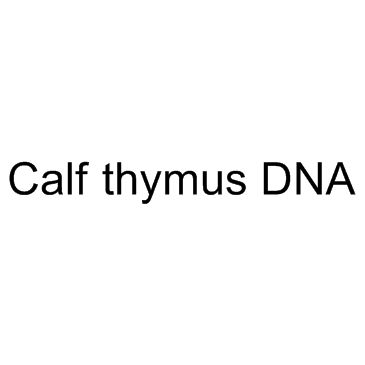Calf thymus DNA

Calf thymus DNA structure
|
Common Name | Calf thymus DNA | ||
|---|---|---|---|---|
| CAS Number | 91080-16-9 | Molecular Weight | N/A | |
| Density | N/A | Boiling Point | N/A | |
| Molecular Formula | C9H13N3Na3O13P3 | Melting Point | N/A | |
| MSDS | USA | Flash Point | N/A | |
|
Broad-spectrum antibodies against self-antigens and cytokines in RAG deficiency.
J. Clin. Invest. 125 , 4135-48, (2015) Patients with mutations of the recombination-activating genes (RAG) present with diverse clinical phenotypes, including severe combined immune deficiency (SCID), autoimmunity, and inflammation. However, the incidence and extent of immune dysregulation in RAG-... |
|
|
Spectroscopic studies on the interaction of sodium benzoate, a food preservative, with calf thymus DNA.
Food Chem. 141(1) , 41-7, (2013) The interaction between sodium benzoate (SB) and calf thymus DNA in simulated physiological buffer (pH 7.4) using acridine orange (AO) dye as a fluorescence probe, was investigated by UV-Vis absorption, fluorescence and circular dichroism (CD) spectroscopy al... |
|
|
In vitro antitumor activity of parent and nano-encapsulated mono cobalt-substituted Keggin polyoxotungstate and its ctDNA binding properties.
Chem. Biol. Interact. 215 , 25-32, (2014) The parent and nanosized starch, and lipid encapsulated K6[SiW11O39Co(H2O)]·nH2O (abbreviated as SEP, LEP and SiW11Co, respectively), as potent antitumor candidates, were synthesized and characterized by FT-IR spectroscopy, ICP, TG analysis, SEM and TEM image... |
|
|
The effect of polyamines on the binding of anti-DNA antibodies from patients with SLE and normal human subjects.
Clin. Immunol. 153(1) , 94-103, (2014) Antibodies to DNA (anti-DNA) are the serological hallmark of systemic lupus erythematosus (SLE). To elucidate specificity further, the effect of polyamines on the binding of anti-DNA antibodies from patients with lupus was tested by ELISA to calf thymus (CT) ... |
|
|
Deciphering the interactions between chlorambucil and calf thymus DNA: a multi-spectroscopic and molecular docking study.
Arch. Biochem. Biophys. 566 , 7-14, (2015) Non-covalent interactions of chlorambucil with calf thymus DNA was investigated using multi-spectroscopic techniques and molecular docking study. Binding constant calculated was found to be 1.54×10(4)M(-1) at 290K, significantly lower than various known inter... |
|
|
An investigation of the photophysical properties of minor groove bound and intercalated DAPI through quantum-mechanical and spectroscopic tools.
Phys. Chem. Chem. Phys. 15(13) , 4596-603, (2013) The fluorescent probe 4',6-diamidino-2-phenylindole (DAPI) is a dye known to interact with polynucleotides in a non-univocal manner, both intercalation and minor groove binding modes being possible, and to specifically change its photophysical properties acco... |
|
|
Naproxen intercalates with DNA and causes photocleavage through ROS generation.
FEBS J. 280(24) , 6569-80, (2013) Naproxen is an important non-steroidal anti-inflammatory drug with many pharmacological and biological properties. In this study, we have attempted to ascertain the mode of action and the mechanism of binding of naproxen to DNA. We have also demonstrated that... |
|
|
Planar triazinium cations from vanadyl-mediated ring cyclizations: the thiazole species for efficient nuclear staining and photocytotoxicity.
Dalton Trans. 42(13) , 4436-49, (2013) Planar triazinium cationic species from vanadyl-assisted cyclization of 1-(2-thiazolylazo)-2-naphthol (H-TAN, 1), 1-(2-pyridylazo)-2-naphthol (H-PAN, 2), 2-(2'-thiazolylazo)-p-cresol (H-TAC, 3) and 6-(2'-thiazolylazo)-resorcinol (H-TAR, 5) were prepared and c... |
|
|
DNA binding and anti-cancer activity of redox-active heteroleptic piano-stool Ru(II), Rh(III), and Ir(III) complexes containing 4-(2-methoxypyridyl)phenyldipyrromethene.
Inorg. Chem. 52(7) , 3687-98, (2013) The synthesis of four novel heteroleptic dipyrrinato complexes [(η(6)-arene)RuCl(2-pcdpm)] (η(6)-arene = C6H6, 1; C10H14, 2) and [(η(5)-C5Me5)MCl(2-pcdpm)] (M = Rh, 3; Ir, 4) containing a new chelating ligand 4-(2-methoxypyridyl)-phenyldipyrromethene (2-pcdpm... |
|
|
RNA Binds to Tau Fibrils and Sustains Template-Assisted Growth.
Biochemistry 54 , 4731-40, (2015) Tau fibrils are the main proteinacious components of neurofibrillary lesions in Alzheimer disease. Although RNA molecules are sequestered into these lesions, their relationship to Tau fibrils is only poorly understood. Such understanding, however, is importan... |